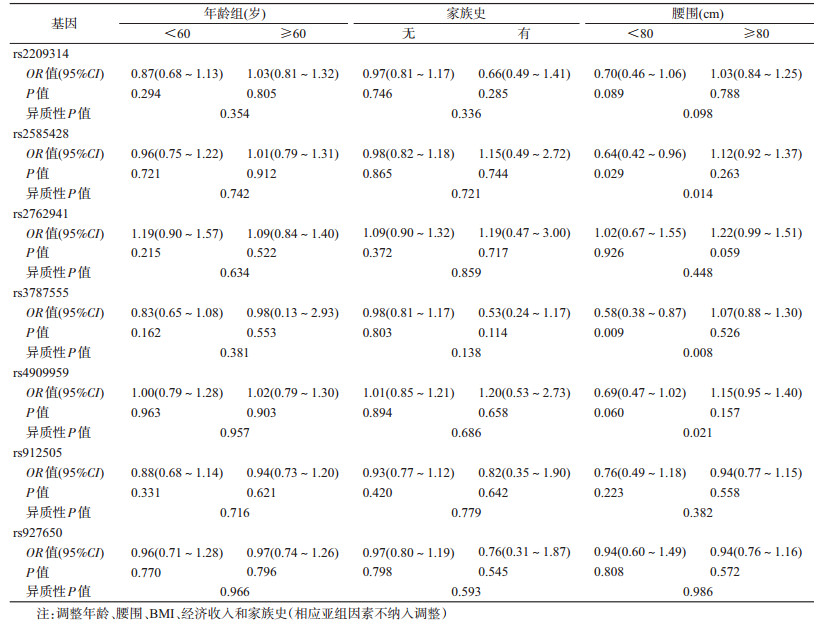文章信息
- 陈福星, 朱政, 崔岚, 俞浩, 韩仁强, 罗鹏飞, 周金意, 武鸣.
- Chen Fuxing, Zhu Zheng, Cui Lan, Yu Hao, Han Renqiang, Luo Pengfei, Zhou Jinyi, Wu Ming
- CYP24A1基因多态性与绝经后女性乳腺癌的易感性研究
- Study on the association between CYP24A1 genetic polymorphisms and risks related to postmenopausal breast cancer
- 中华流行病学杂志, 2020, 41(6): 934-939
- Chinese Journal of Epidemiology, 2020, 41(6): 934-939
- http://dx.doi.org/10.3760/cma.j.cn112338-20190920-00685
-
文章历史
收稿日期: 2019-09-20
2. 江苏省疾病预防控制中心慢性非传染病防制所, 南京 210009
2. Department of Chronic Disease Control, Jiangsu Provincial Center for Disease Control and Prevention, Nanjing 210009, China
乳腺癌是女性中常见的恶性肿瘤[1],其确切的发病机制仍未完全阐明。维生素D不仅能维持钙稳态作用,由于在细胞分化,增殖和凋亡过程中起调节作用,还可以对乳腺癌在内的癌症起保护性作用[2],因此维生素D通路相关基因可能与乳腺癌的发生发展存在联系[3]。细胞色素P450 CYP24A1基因位于20q13染色体上,编码24羟化酶,能降解维生素D代谢产物25-羟基维生素D[25(OH)D]和1,25-二羟维生素D[1,25(OH)2D]使其失活。研究发现24羟化酶在乳腺癌患者中表达上调[4],可能导致1,25(OH)2D介导的生长抑制,所以CYP24A1基因被认为是乳腺癌的潜在致癌基因[5]。已有研究发现,CYP24A1基因多态性与乳腺癌的关联在不同人群中呈现不同结果[6],但中国人群中的相关研究较少。由于绝经前后伴随着雌孕激素水平的变化对结果影响较大,本研究采用病例对照研究的方法探讨绝经后女性人群中CYP24A1基因多态性是否与乳腺癌风险存在关联。
对象与方法1.研究对象:在江苏省无锡市开展的以人群为基础的乳腺癌病例对照研究,纳入在无锡市居住≥5年的女性。从当地肿瘤登记系统选取2013年11月至2014年11月期间新发乳腺癌患者(ICD-10:C50)作为病例组,对照组根据病例情况进行年龄相差5岁匹配,同时排除患有其他癌症的个体。研究对象的排除标准:①患有其他严重疾病(癌症或急性病);②非原发性乳腺癌或从其他部位转移的癌症;③未能完成调查问卷的人员。共有1 410名新发病例,同时选取1 072名对照。根据应答和排除信息不完整,最终纳入818例病例和935例对照。本研究选取的对象为绝经后人群,共有589例病例和545例对照。本研究通过江苏省CDC伦理委员会审查,所有参与者均签署了知情同意书。
2.流行病学调查:调查内容包括问卷调查、身体测量、血样采集和实验室检测4项内容。由经过培训的调查员通过面访对研究对象进行问卷调查。问卷的内容涵盖了人口学资料特征(年龄、经济收入、文化程度等)、生活方式(吸烟、饮酒、体力活动等)、女性的生理因素(月经、生育史等)、还包括癌症家族史和环境因素等。现场还测量了身高、体重、腰围、胸围等人体测量指标[7]。每个指标重测2次保证数据的准确性。质量控制贯穿全过程,现场调查员测量后,质控人员随机抽取5%的调查对象进行再次测量,重测2次与之前结果进行比对。
3.位点选取和基因分型:利用文献进行CYP24A1基因遗传位点的筛选[6, 8-9]。筛选标准:①SNP最小等位基因频率(MAF)>5%;②已有相关文献报道。共选出7个基因单核苷酸多态性(SNP)位点,即CYP24A1基因的rs2209314、rs2585428、rs2762941、rs3787555、rs4909959、rs912505和rs927650。采集受试对象5 ml静脉血。使用QIAamp DNA Blood Mini Kit(QIAGEN,Germany)对200 μl外周血提取DNA,并将所提取的DNA置于-80 ℃冰箱保存。应用Sequenom MassARRAY平台对CYP24A1基因多态性进行分型。随机选取5%的样本进行质量控制,重测结果的一致性为100%。对照组CYP24A1的基因型满足哈迪-温伯格平衡(HWE)。
4.变量定义:BMI(kg/m2)为体重(kg)除以身高(m)的平方,分为<18.5(低体重),18.5~(正常),24.0~(超重)和≥28.0(肥胖)组[10]。根据WHO对亚洲女性的建议,将腰围≥80 cm定义为腰围增加[11]。家族史指某种病在家族成员(不仅限于直系亲属)中的发病情况。
5.统计学分析:使用EpiData 3.0软件建立数据库并利用R 3.5.0软件进行统计学分析。计数资料采用χ2检验,计量资料当方差齐用t检验,不齐时采用Welch’s t检验进行两组间基线特征比较。使用logistic回归模型在调整年龄、腰围、BMI、经济收入和家族史后,分别采用共显性、显性、隐性和相加模型评估基因型和乳腺癌风险之间的OR值和95%CI[12]。分层分析使用相加模型评估CYP24A1多态性与乳腺癌关联。使用基于χ2的Q检验,检测亚组间的异质性。为了减少因部分个体基因型缺失可能造成的偏倚,对基因型缺失的对象进行剔除后,使用GMDR v0.7软件进行多因子降维分析位点-位点之间的交互作用[13]。以双侧检验P<0.05为差异有统计学意义。
结果1.一般情况:病例组和对照组年龄差异有统计学意义(P<0.001),初潮年龄、初产年龄和绝经年龄差异无统计学意义(P>0.05)。病例组腰围(89.02 cm)高于对照组(85.46 cm)。对照组的46.79%处于BMI正常范围,而病例组更倾向于超重。病例组和对照组的经济收入和家族史差异有统计学意义,文化程度和口服避孕药史差异无统计学意义。见表 1。
2. CYP24A1基因多态性与乳腺癌关联:采用多因素logistic回归模型,调整了年龄、腰围、BMI、经济收入和家族史后,rs2209314、rs2585428、rs2762941、rs3787555、rs4909959、rs912505和rs927650在4种模型下和乳腺癌的关联均无统计学意义(P>0.05)。见表 2。
3.分层分析:按照年龄、家族史和腰围分层,使用相加模型进一步评估亚组间的乳腺癌发病风险关联(表 3)。在年龄和家族史的各亚组间,关联无统计学意义。在腰围<80 cm的亚组中,rs2585428与乳腺癌风险存在关联(OR=0.64,95%CI:0.42~0.96),而在腰围≥80 cm的亚组中未发现上述关联。类似地,在腰围<80 cm的亚组中,rs3787555能降低乳腺癌发生风险(OR=0.58,95%CI:0.38~0.87),而在腰围≥80 cm的亚组中并未能改变乳腺癌风险。亚组间异质性检验结果发现,rs2585428和rs3787555在腰围的两个亚组中存在异质性(P=0.014和0.008),rs4909959在腰围亚组间的效应值差异有统计学意义(P=0.021)。
4.基因多态性与腰围的交互作用分析:在调整年龄、BMI、经济收入和家族史后,将rs2585428、rs3787555和rs4909959与腰围进行交互作用分析发现,rs2585428、rs3787555和rs4909959与腰围在乳腺癌发病风险存在交互作用(表 4)。
5.位点-位点的交互作用分析:采用广义多因子降维方法分析位点-位点的交互作用,5个模型结果均无统计学意义。最佳交互作用模型包含了CYP24A1基因的rs2209314、rs3787555和rs912505,训练样本精确度为0.564 9,验证样本精确度为0.513 6,交叉验证一致性为9/10(P=0.054 7)。见表 5。
本研究分析了CYP24A1的rs2209314、rs2585428、rs2762941、rs3787555、rs4909959、rs912505和rs927650基因多态性与绝经后女性乳腺癌发病风险的关联,发现在腰围<80 cm组中,CYP24A1的rs2585428和rs3787555能降低绝经后乳腺癌发病风险,且位点-位点交互作用结果提示CYP24A1遗传变异可能与乳腺癌易感性相关。
CYP24A1基因作为细胞色素P450家族的成员之一,可合成用于降解25(OH)D和1,25(OH)2D3所需的24羟化酶。研究表明,在CYP24A1缺失情况下,1,25(OH)2D3不能转化为非活性的1,24,25(OH)3D3,而过多的1,25(OH)2D3会导致维生素D产生毒性作用,不能发挥维生素D抑制肿瘤血管、细胞相互黏附刺激等作用,进而不能发挥其降低癌症发病风险作用[14-15]。已有研究证实,CYP24A1基因可能在癌症的发生发展中起着重要作用[14-19]。国外研究也提出,CYP24A1基因的不同位点和乳腺癌的风险关联存在种族差异[6],而当乳腺癌未细分为雌激素阴性或者是阳性时,rs3787555和rs912505与乳腺癌不相关,与本研究结果一致,提示CYP24A1的遗传变异在不同亚型乳腺癌的易感性不同。本研究还发现,CYP24A1的rs2209314不能降低绝经后乳腺癌发病风险,但韩国前列腺癌研究中,rs2209314能降低约30%前列腺癌发病风险[20],可能由于性别和癌症类型差异所致。
此外,本研究还发现CYP24A1的rs2585428、rs3787555和rs4909959多态性与腰围在乳腺癌发病风险中存在交互作用,在腰围<80 cm组中,rs2585428发生乳腺癌风险降低36%,而不同基因型降低发病风险的能力略有不同,提示SNP与腰围可能通过某种共同作用机制降低乳腺癌风险。既往研究发现,在腰围>80 cm的女性人群患代谢综合征风险更高[21]。肥胖可以通过功能失调的胰岛素样生长因子信号传导,异常脂肪因子水平和炎症通路的异常调节机制增加乳腺癌风险[22]。本研究通过使用广义多因子降维方法对位点-位点之间的交互作用分析,虽然未发现rs2209314、rs3787555和rs912505存在显著的位点-位点交互作用(P=0.054 7),但P值处于界值边缘,提示这3种SNP可能通过基因型组合共同改变乳腺癌的发病风险,但具体的作用机制可能还需要更大的人群来发现和验证。
本研究存在一定的局限性。一是本研究仅探讨了江苏省无锡市绝经后女性中CYP24A1基因多态性与乳腺癌风险关联,结论在外推时可能存在局限性。二是本研究未对乳腺癌进行分型,未能进一步探究这些SNP与不同类型的乳腺癌的发病风险是否一致。因此,需要更多类似研究来进行验证。
综上所述,CYP24A1的rs2585428和rs3787555与女性绝经后乳腺癌发病风险相关,并且rs2585428、rs3787555和rs4909959与腰围在乳腺癌易感性存在交互作用。进一步提示了遗传因素结合环境因素共同影响了乳腺癌的发病风险。
利益冲突 所有作者均声明不存在利益冲突
志谢 感谢所有参加乳腺癌项目成员和无锡市现场实施调查的调查员以及为项目经费付出努力的成员
| [1] |
Bray F, Ferlay J, Soerjomataram I, et al. Global cancer statistics 2018:GLOBOCAN estimates of incidence and mortality worldwide for 36 cancers in 185 countries[J]. CA Cancer J Clin, 2018, 68(6): 394-424. DOI:10.3322/caac.21492 |
| [2] |
O'Brien KM, Sandler DP, Taylor JA, et al. Serum Vitamin D and risk of breast cancer within five years[J]. Environ Health Perspect, 2017, 125(7): 77004. DOI:10.1289/EHP943 |
| [3] |
Mccullough ML, Bostick RM, Mayo TL. Vitamin D gene pathway polymorphisms and risk of colorectal, breast, and prostate cancer[J]. Annu Rev Nutr, 2009, 29: 111-132. DOI:10.1146/annurev-nutr-080508-141248 |
| [4] |
Townsend K, Banwell CM, Guy M, et al. Autocrine metabolism of vitamin D in normal and malignant breast tissue[J]. Clin Cancer Res, 2005, 11(9): 3579-3586. DOI:10.1158/1078-0432.CCR-04-2359 |
| [5] |
Osanai M, Lee GH. CYP24A1-induced vitamin D insufficiency promotes breast cancer growth[J]. Oncol Rep, 2016, 36(5): 2755-2762. DOI:10.3892/or.2016.5072 |
| [6] |
Yao S, Zirpoli G, Bovbjerg DH, et al. Variants in the vitamin D pathway, serum levels of vitamin D, and estrogen receptor negative breast cancer among African-American women:a case-control study[J]. Breast Cancer Res, 2012, 14(2): R58. DOI:10.1186/bcr3162 |
| [7] |
Lu SR, Qian Y, Huang XY, et al. The association of dietary pattern and breast cancer in Jiangsu, China:A population-based case-control study[J]. PLoS One, 2017, 12(9): e184453. DOI:10.1371/journal.pone.0184453 |
| [8] |
Pibiri F, Kittles RA, Sandler RS, et al. Genetic variation in vitamin D-related genes and risk of colorectal cancer in African Americans[J]. Cancer Causes Control, 2014, 25(5): 561-570. DOI:10.1007/s10552-014-0361-y |
| [9] |
Batai K, Murphy AB, Shah E, et al. Common vitamin D pathway gene variants reveal contrasting effects on serum vitamin D levels in African Americans and European Americans[J]. Hum Genet, 2014, 133(11): 1395-1405. DOI:10.1007/s00439-014-1472-y |
| [10] |
Chen CM, Lu FC, Department of Disease Control Ministry of Health, PR China. The guidelines for prevention and control of overweight and obesity in Chinese adults[J]. Biomed Environ Sci, 2004, 17(Suppl): 1-36. |
| [11] |
Zhou BF, the Cooperative Meta-analysis Group of Working Group on Obesity in China. Predictive values of body mass index and waist circumference for risk factors of certain related diseases in Chinese adults-study on optimal cut-off points of body mass index and waist circumference in Chinese adults[J]. Asia Pacific J Clin Nutrit, 2002, 11(Suppl 8): S685-693. DOI:10.1046/j.1440-6047.11.s8.9.x |
| [12] |
Calle ML, Urrea V, Vellalta G, et al. Improving strategies for detecting genetic patterns of disease susceptibility in association studies[J]. Stat Med, 2008, 27(30): 6532-6546. DOI:10.1002/sim.3431 |
| [13] |
范伟, 沈超, 郭志荣. 基于模型的多因子降维方法在基因-基因/环境交互作用分析中的应用[J]. 中华流行病学杂志, 2015, 36(11): 1305-1310. Fan W, Shen C, Guo ZR. Detecting gene-gene/environment interactions by model-based multifactor dimensionality reduction[J]. Chin J Epidemiol, 2015, 36(11): 1305-1310. DOI:10.3760/cma.j.issn.0254-6450.2015.11.024 |
| [14] |
Mehta RG, Peng XJ, Alimirah F, et al. Vitamin D and breast cancer:emerging concepts[J]. Cancer Lett, 2013, 334(1): 95-100. DOI:10.1016/j.canlet.2012.10.034 |
| [15] |
Garland CF, Garland FC, Gorham ED, et al. The role of vitamin D in cancer prevention[J]. Am J Public Health, 2006, 96(2): 252-261. DOI:10.2105/AJPH.2004.045260 |
| [16] |
Zhalehjoo N, Shakiba Y, Panjehpour M. Gene expression profiles of CYP24A1 and CYP27B1 in malignant and normal breast tissues[J]. Mol Med Rep, 2017, 15(1): 467-473. DOI:10.3892/mmr.2016.5992 |
| [17] |
Shiratsuchi H, Wang ZW, Chen GA, et al. Oncogenic potential of CYP24A1 in lung adenocarcinoma[J]. J Thorac Oncol, 2017, 12(2): 269-280. DOI:10.1016/j.jtho.2016.10.010 |
| [18] |
Sun HY, Wang CW, Hao M, et al. CYP24A1 is a potential biomarker for the progression and prognosis of human colorectal cancer[J]. Hum Pathol, 2016, 50: 101-108. DOI:10.1016/j.humpath.2015.11.008 |
| [19] |
Lopes N, Sousa B, Martins D, et al. Alterations in Vitamin D signaling and metabolic pathways in breast cancer progression:a study of VDR, CYP27B1 and CYP24A1 expression in benign and malignant breast lesions Vitamin D pathways unbalanced in breast lesions[J]. BMC Cancer, 2010, 10: 483. DOI:10.1186/1471-2407-10-483 |
| [20] |
Oh JJ, Byun SS, Lee SE, et al. Genetic variants in the CYP24A1 gene are associated with prostate cancer risk and aggressiveness in a Korean study population[J]. Prostate Cancer Prostatic Dis, 2014, 17(2): 149-156. DOI:10.1038/pcan.2014.1 |
| [21] |
Powell C, Browne LD, Carson BP, et al. Use of compositional data analysis to show estimated changes in cardio metabolic health by reallocating time to light-intensity physical activity in older adults[J]. Sports Med, 2019, 50(1): 205-217. DOI:10.1007/s40279-019-01153-2 |
| [22] |
James FR, Wootton S, Jackson A, et al. Obesity in breast cancer-what is the risk factor?[J]. Eur J Cancer, 2015, 51(6): 705-720. DOI:10.1016/j.ejca.2015.01.057 |
 2020, Vol. 41
2020, Vol. 41







